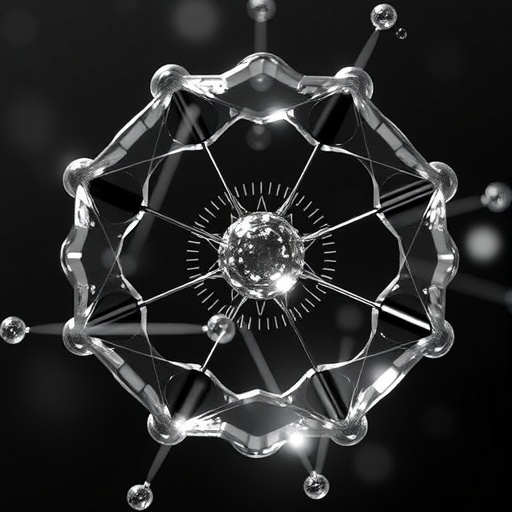In the relentless pursuit of next-generation semiconductor materials, organic–inorganic halide perovskites have emerged as a beacon of promise, captivating researchers worldwide with their remarkable optoelectronic properties and cost-effective manufacturing potential. Yet, despite intense scientific scrutiny, the atomic-scale understanding of these materials—particularly at their edges and defect sites—remained elusive. This is a critical gap, as edges and defects, though occupying only a tiny fraction of a crystal’s lattice, wield a disproportionate influence on performance and stability.
A groundbreaking study now shatters this barrier, unveiling, for the first time, atomically resolved images of edges and defects within methylammonium lead iodide (MAPbI3), a prototypical halide perovskite system. This feat was made possible by deploying an innovative ultralow-dose, high-speed four-dimensional scanning transmission electron microscopy (4D-STEM) technique combined with ptychography—a computational phase retrieval method enabling enhanced resolution and sensitivity. The authors claim this represents the lowest electron dose ever achieved for atomic resolution imaging, a critical advancement given the extreme beam sensitivity of halide perovskites.
The significance of this advance goes beyond mere imaging novelty. The acquired atomic-resolution maps revealed a predominance of methylammonium (MA) and iodine (I) termination at crystal edges, a detail of immense importance for understanding chemical stability and interfacial electronic structure. Such edge terminations dictate how these materials interact with their environment and affect charge carrier dynamics, influencing the efficiency and lifetime of devices such as solar cells and photodetectors.
Critically, the study sheds light on the dynamics of damage and degradation pathways at these edges and internal defect sites. It was observed that the damage rate is closely correlated with the type and concentration of vacancies—missing atoms in the crystal lattice—which act as focal points for degradation. Among these, iodine vacancies stood out as particularly detrimental, accelerating the breakdown of perovskite structure under electron beam exposure.
The implications for materials design are profound. By pinpointing which atomic configurations and defects exacerbate instability, new strategies can be devised to suppress vacancy formation or passivate existing defects. This could lead not only to improved longevity of perovskite-based devices but also enhanced optoelectronic performance owing to reduced non-radiative recombination at defect sites.
From a methodological perspective, this work showcases the power of integrating ultralow-dose 4D-STEM with dose fractionation and advanced ptychographic reconstruction algorithms. Traditional electron microscopy techniques have often failed to image such beam-sensitive materials without inflicting severe damage, thus masking their true atomic arrangements. The authors’ approach mitigates this issue by distributing the electron dose across multiple frames, allowing for dynamic studies of structural evolution over time—a window into the real-time behavior of edges and defects under operational or experimental conditions.
Furthermore, the structural dynamics observed reveal the complex interplay between intrinsic lattice instabilities and external perturbations. The ability to directly visualize defect migration, edge reconstruction, and vacancy formation at atomic scales affords unprecedented insight into degradation mechanisms, paving the way for the rational design of more resilient halide perovskite materials.
This study also transcends academic curiosity, holding substantial promise for industrial applications. As perovskite-based solar cells and optoelectronic devices inch closer to commercialization, understanding and controlling stability issues is paramount. The fundamental knowledge gained here could feed into quality control during synthesis, tailor surface treatments, and guide the engineering of interfaces, all critical to ensuring device robustness in real-world environments.
Moreover, the work stands as a testament to the evolving landscape of electron microscopy itself, highlighting how cutting-edge instrument capabilities and computational techniques jointly redefine our capacity to probe matter at its most fundamental level without compromising structural integrity.
In summary, the research ushers in a new era of atomic-precision characterization of halide perovskites, capturing their elusive edge structures and defect configurations with unmatched clarity and minimal damage. These insights not only enrich fundamental understanding but also catalyze advances in device optimization, heralding a bright future for perovskite semiconductors in sustainable energy technologies.
As the field moves forward, extending these methodologies to a broader class of perovskite compositions and heterostructures will be crucial. Future efforts integrating in situ environmental capabilities may further elucidate how operational stresses such as light, heat, and moisture exacerbate defect behavior. Ultimately, this work lays the groundwork for transformative breakthroughs in both materials science and renewable energy applications.
The atomic-scale revelations presented offer a roadmap for researchers and technologists to harness the full potential of halide perovskites, marrying exquisite structural understanding with practical engineering to push the frontiers of semiconductor science forward. This convergence of technique and insight underscores the exciting journey from fundamental observation to real-world impact in a rapidly advancing technological landscape.
Subject of Research: Atomic-scale characterization of edges and defects in organic–inorganic lead halide perovskites.
Article Title: Atomically resolved edges and defects in lead halide perovskites.
Article References:
Yuan, B., Wang, Z., Zhang, S. et al. Atomically resolved edges and defects in lead halide perovskites. Nature (2025). https://doi.org/10.1038/s41586-025-09693-6
Image Credits: AI Generated
Tags: atomic-scale imaging techniqueschemical stability of perovskitesdefects in semiconductor materialsedge termination in crystalsfour-dimensional scanning transmission electron microscopyHalide Perovskitesinterfacial electronic structuremethylammonium lead iodidenext-generation semiconductor researchoptoelectronic properties of materialsptychography in materials scienceultralow-dose electron microscopy





